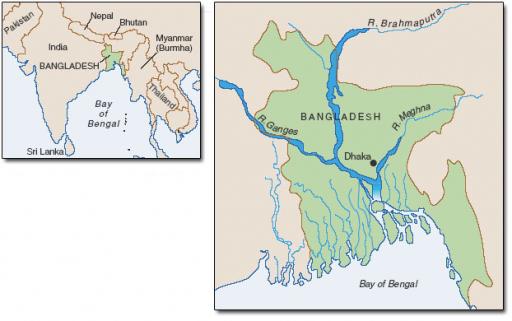3.2 The impact of climate change on global freshwater resources
The availability of freshwater will be significantly altered in a future world affected by climate change (Houghton, 2004). In some regions, water availability will decrease; in others it will increase. Precise predictions about the extent and exact location of such changes cannot be made because they are based on climate models, the accuracy of which is uncertain. However, there is wide agreement that probable changes will include:
-
More rain in northern high latitudes in winter and in the monsoon regions of south east Asia in summer.
-
Less rain in southern Europe, Central America, southern Africa and Australia in summer.
-
Greater water flows in rivers that are fed by glaciers.
-
Overall, higher temperatures in all regions, which will lead to greater evaporation so that, even in regions where rainfall does not decrease, water availability will be reduced.
-
Rising sea levels, which will lead to flooding of low-lying coastal regions, including major flood plains and river deltas, many of which are currently densely populated; for example, the Bengal delta in Bangladesh contains 8.5 million people (Hecht, 2006) (see Figure 6).

The impact of Hurricane Katrina on the Mississippi delta in southern USA in 2005 revealed some of the adverse effects of human activities on river deltas. Control of water flow higher up-river reduces the amount of sediment reaching a delta, causing the land to subside. This is exacerbated by extraction of groundwater within the delta. Rising sea levels, resulting from climate change, may then threaten to inundate the lowered delta, especially during very severe weather (Hecht, 2006). In the Mississippi delta, the situation was exacerbated by inadequate maintenance of flood barriers.
As a result of the changes listed above, some regions will experience a greater frequency of flooding, while others will experience more frequent and more severe droughts. These changes will affect human health directly, as well as indirectly by disrupting agriculture and the supply of food.
The impending water crisis is bringing about a major change in the way that the water extraction industry approaches its task (Gleick, 2003). In the past, the emphasis was on finding more effective ways of extracting water from natural resources; now the emphasis is on finding more efficient ways to use it. For example, in California considerable reductions in water use have been achieved. More efficient ways of irrigating farmland have been developed that decrease the amount of water lost by evaporation to the air. Domestic use of water has been reduced by the introduction of new designs of toilets, showers, washing machines and dishwashers. For example, domestic consumption of water to dispose of sewage in the USA has been reduced by 75% over 20 years by changes in toilet design. Similar reductions in domestic water use have been achieved in Australia, Japan and Europe (Gleick, 2003).
Original Copyright © 2007 The Open University. Now made available within the Creative Commons framework under the CC Attribution – Non-commercial licence (see http://creativecommons.org/by-nc-sa/2.0/uk/).